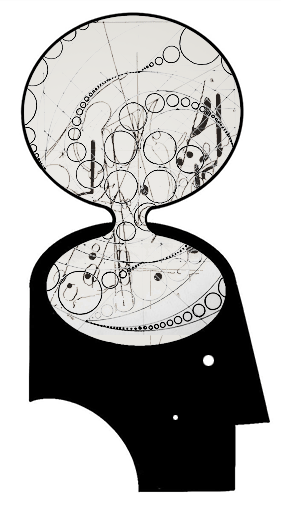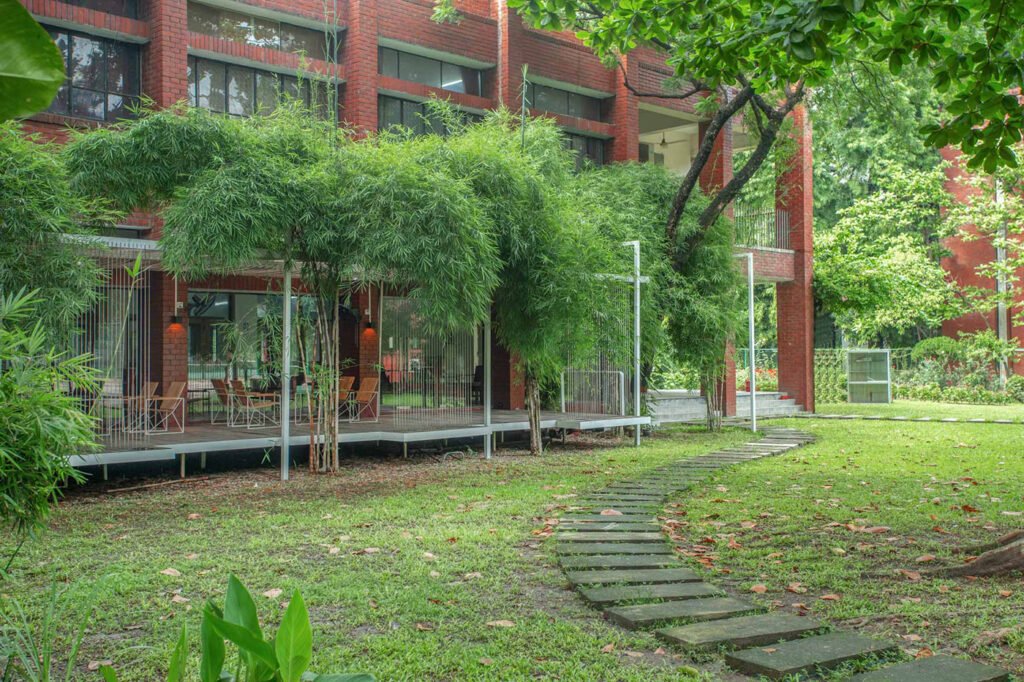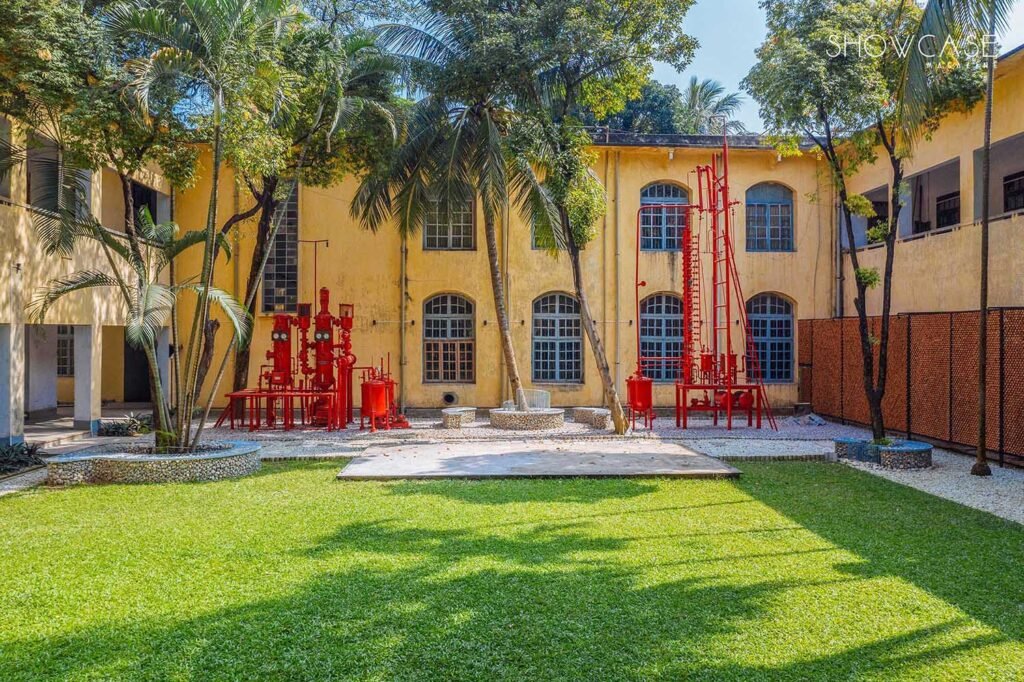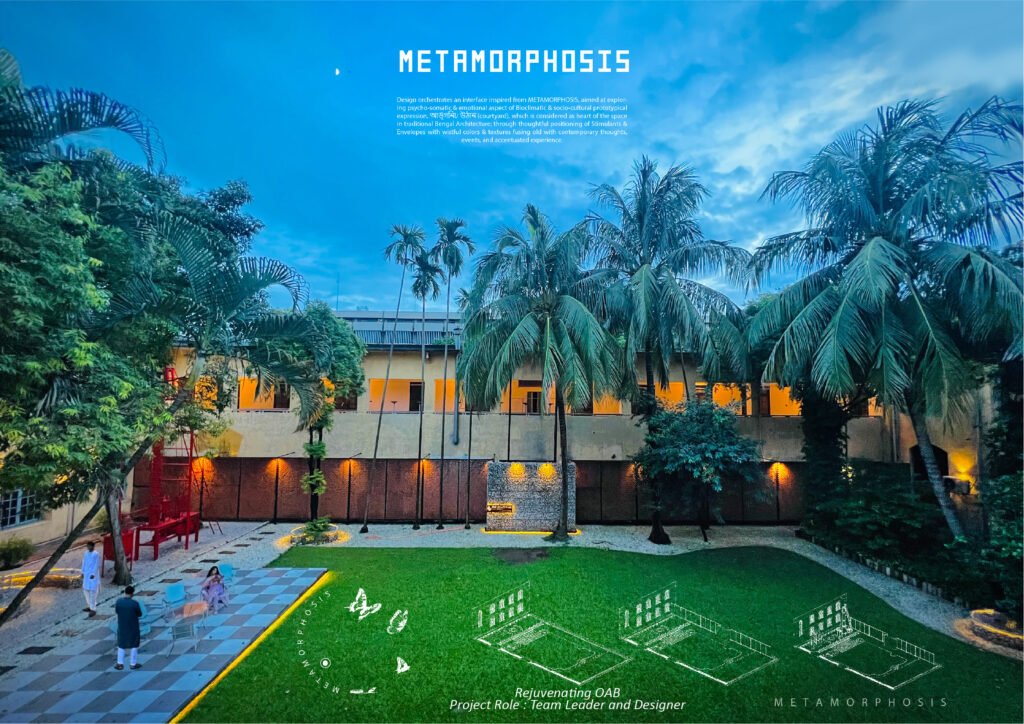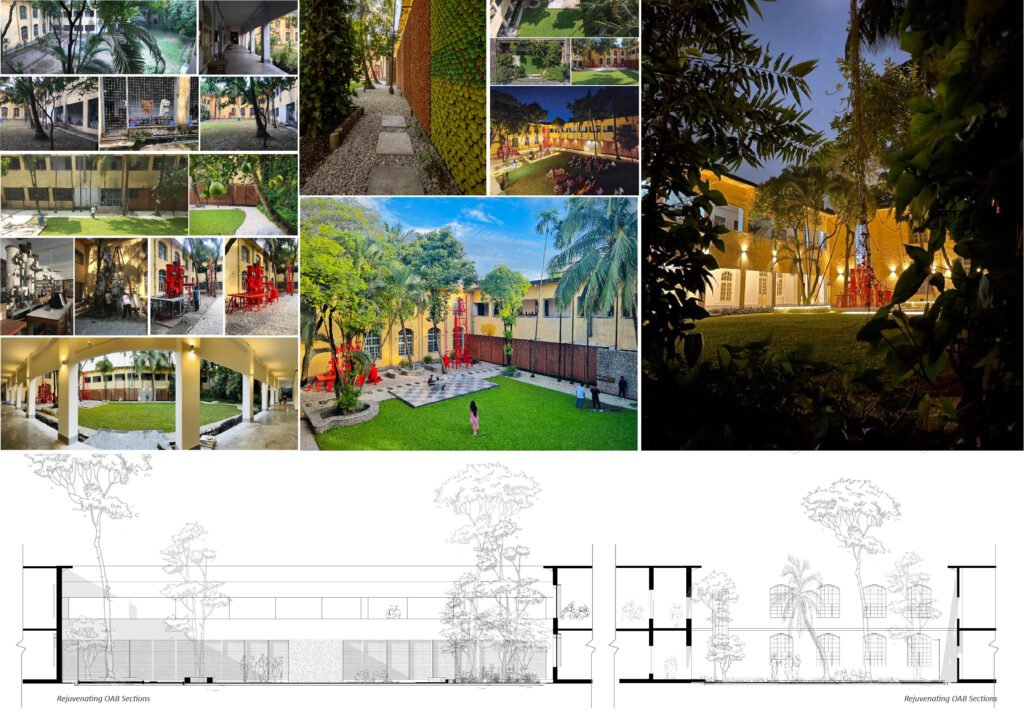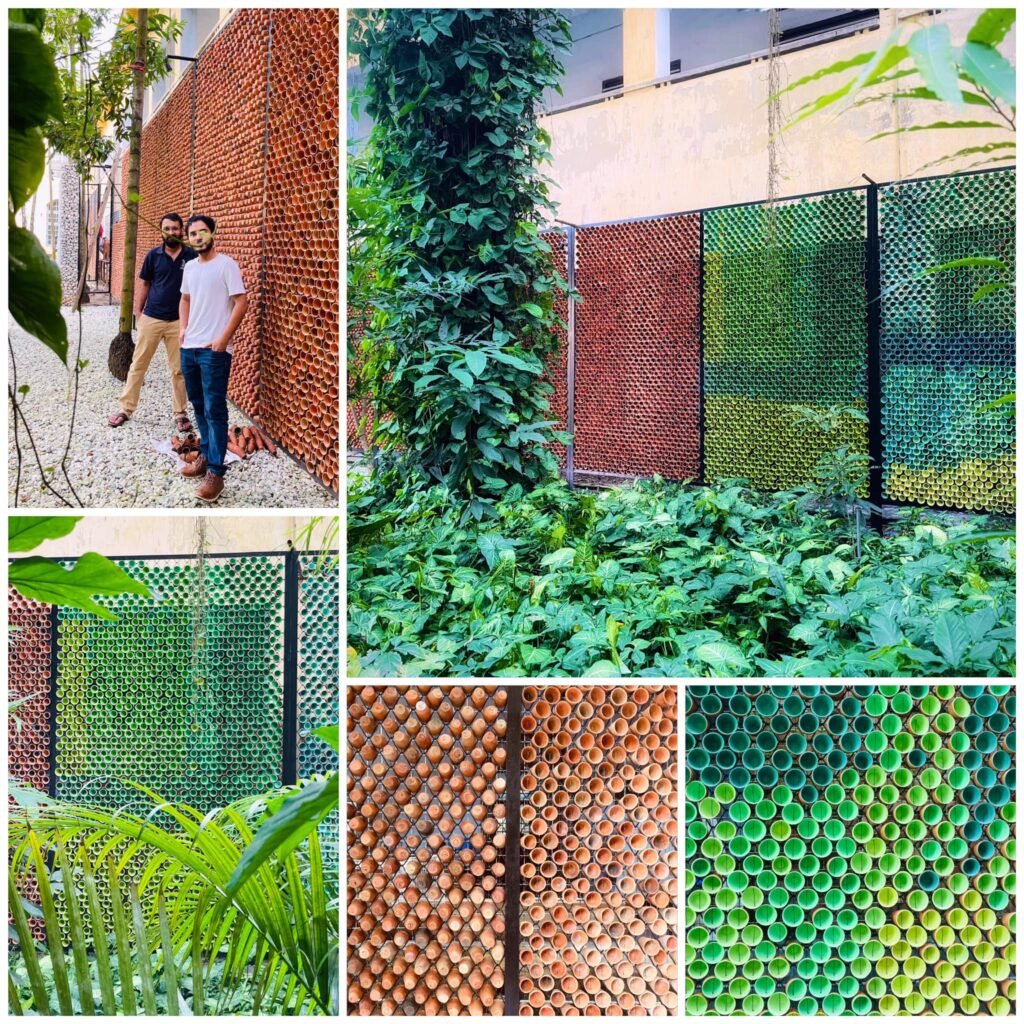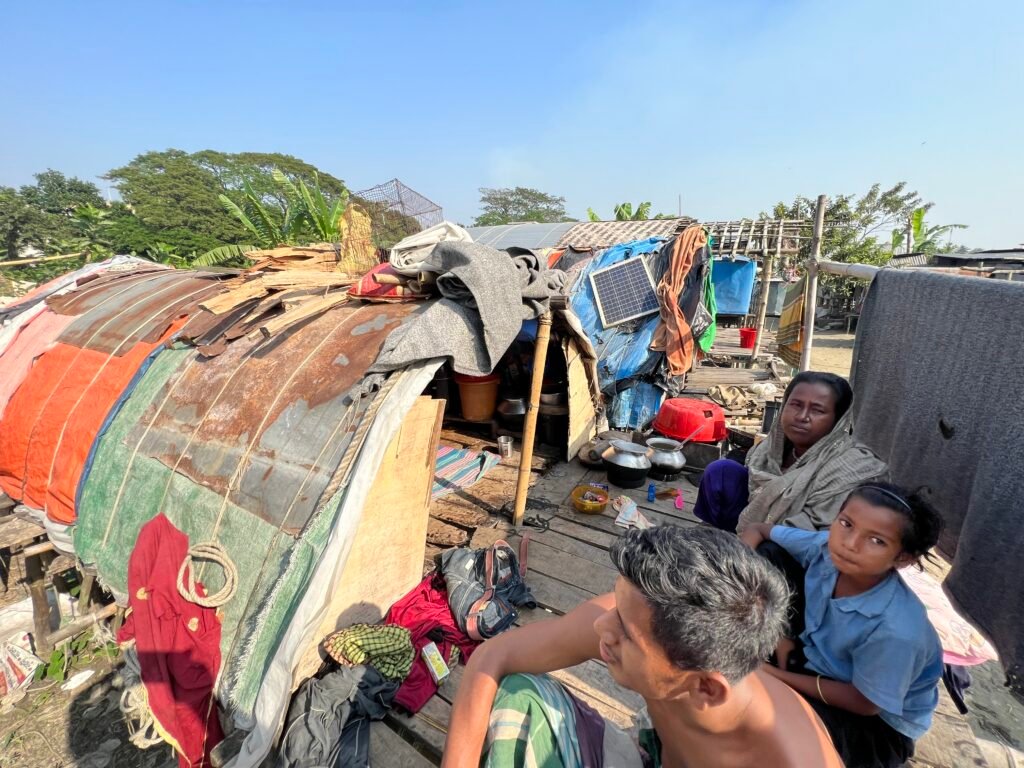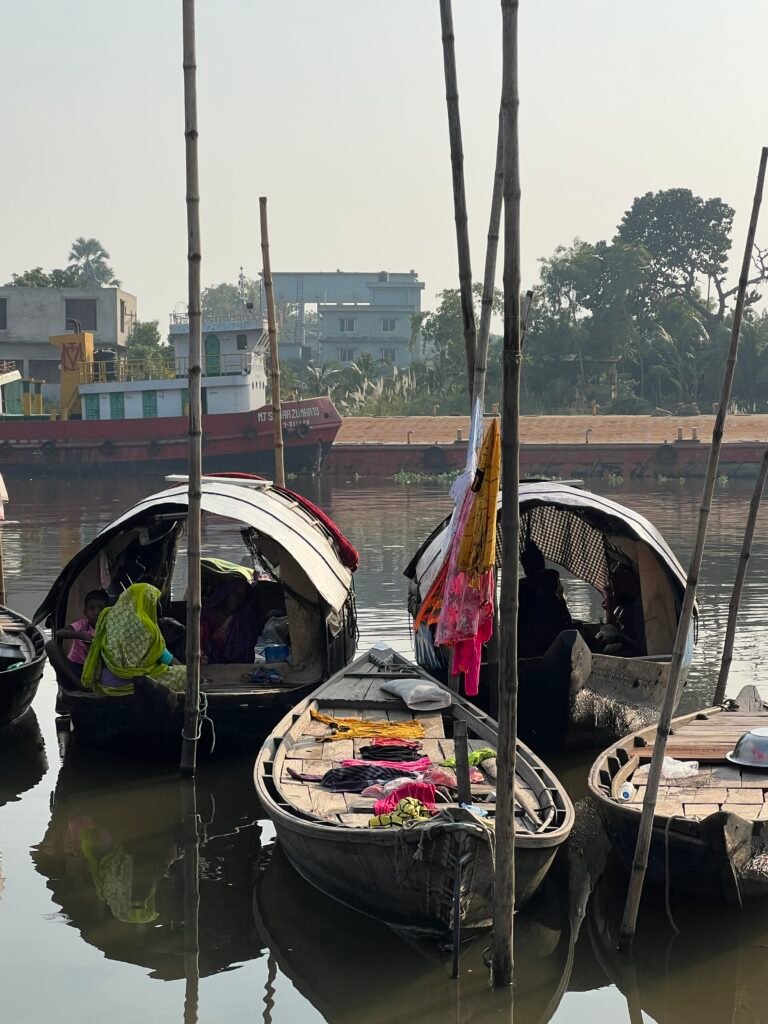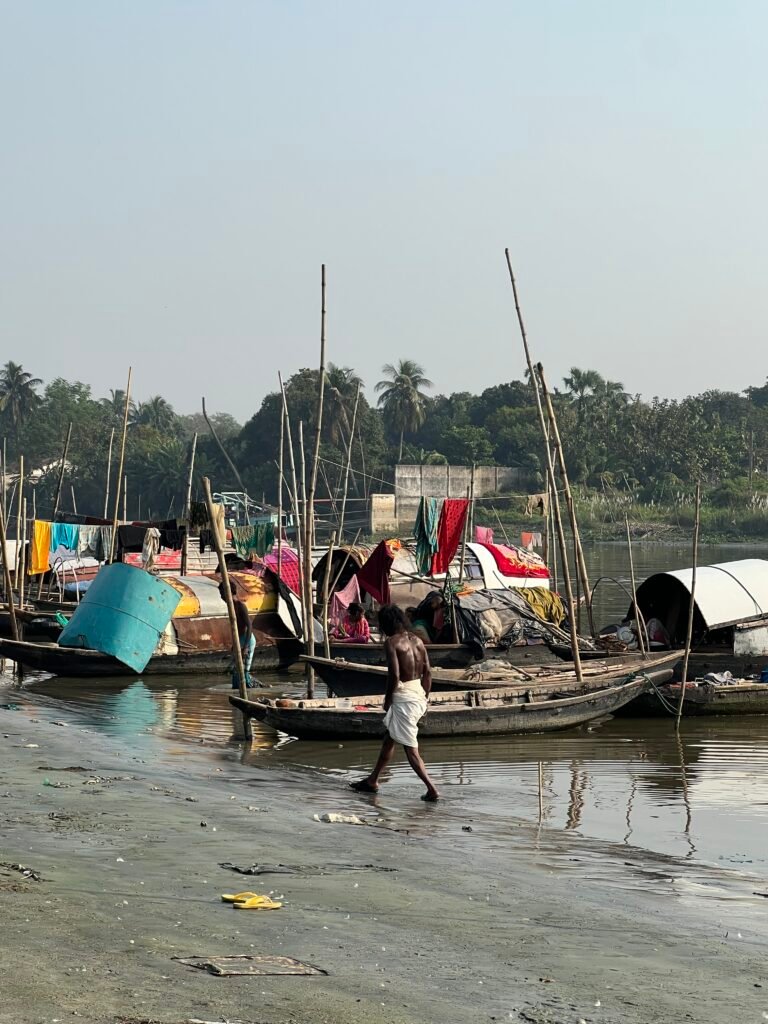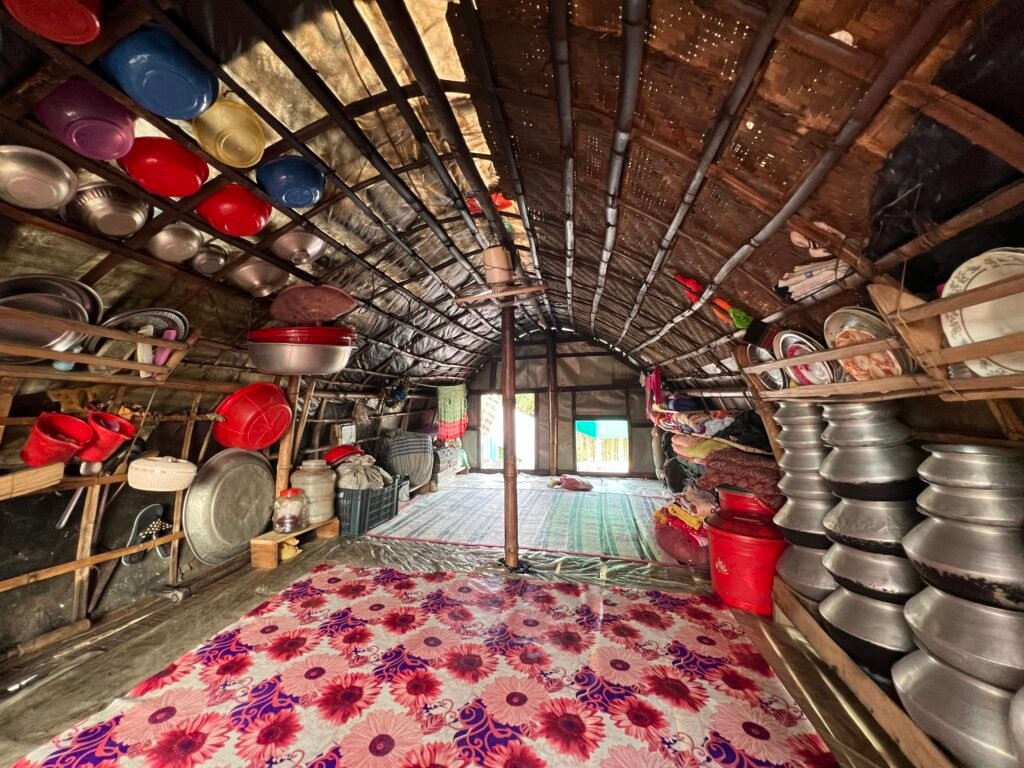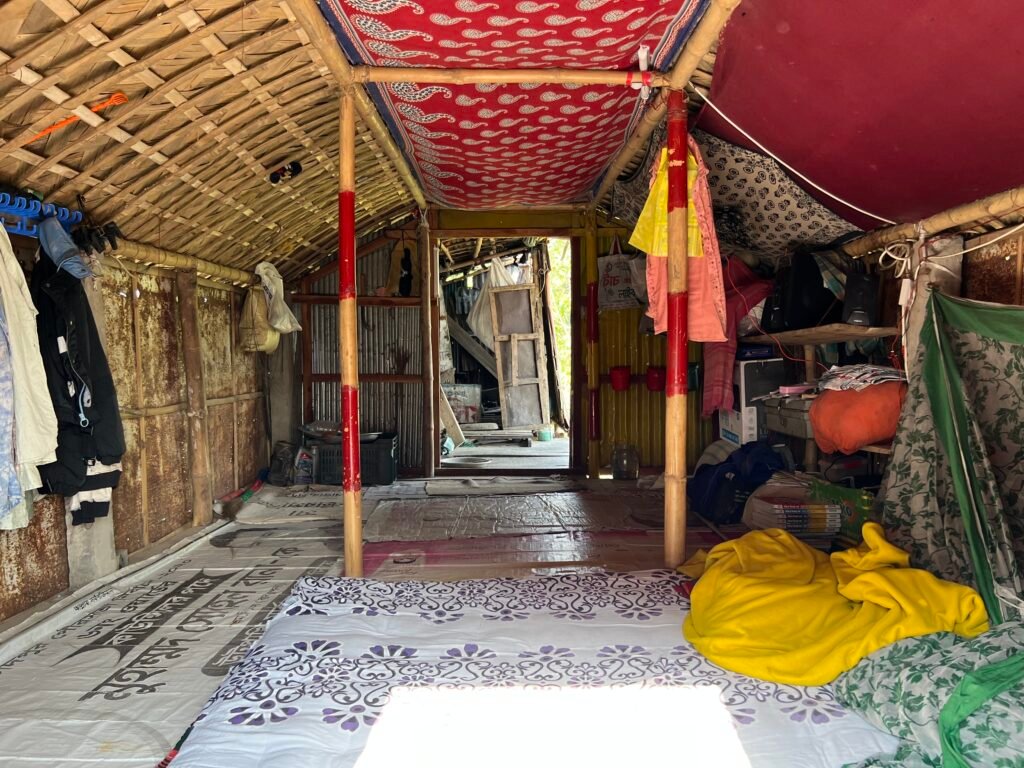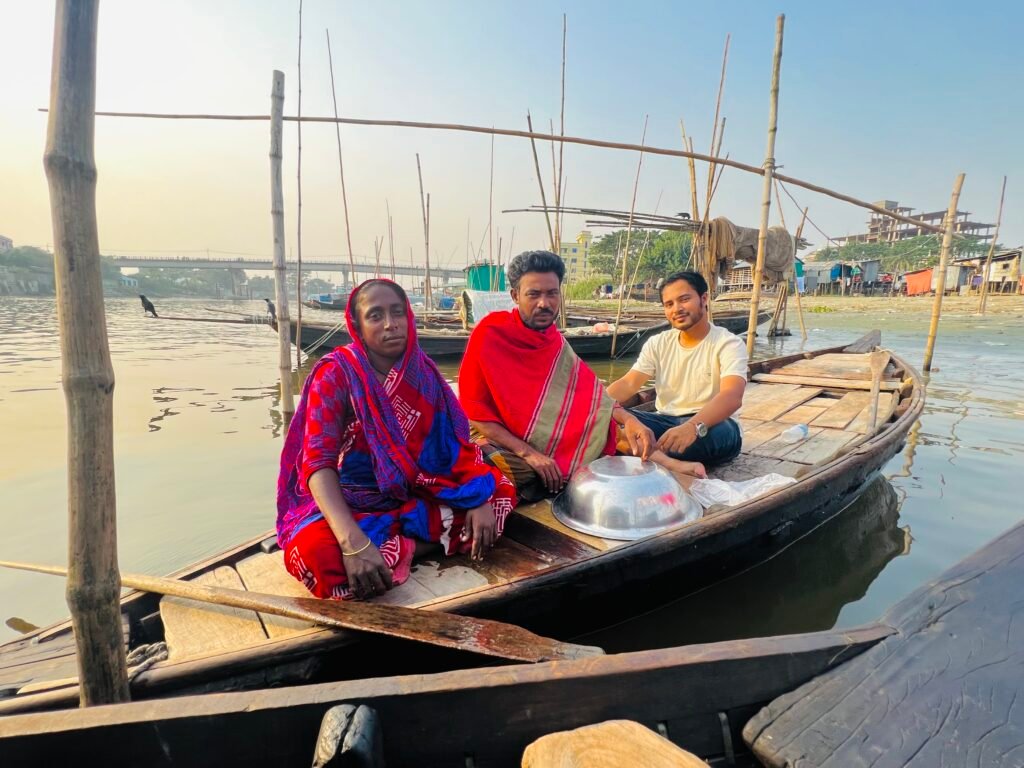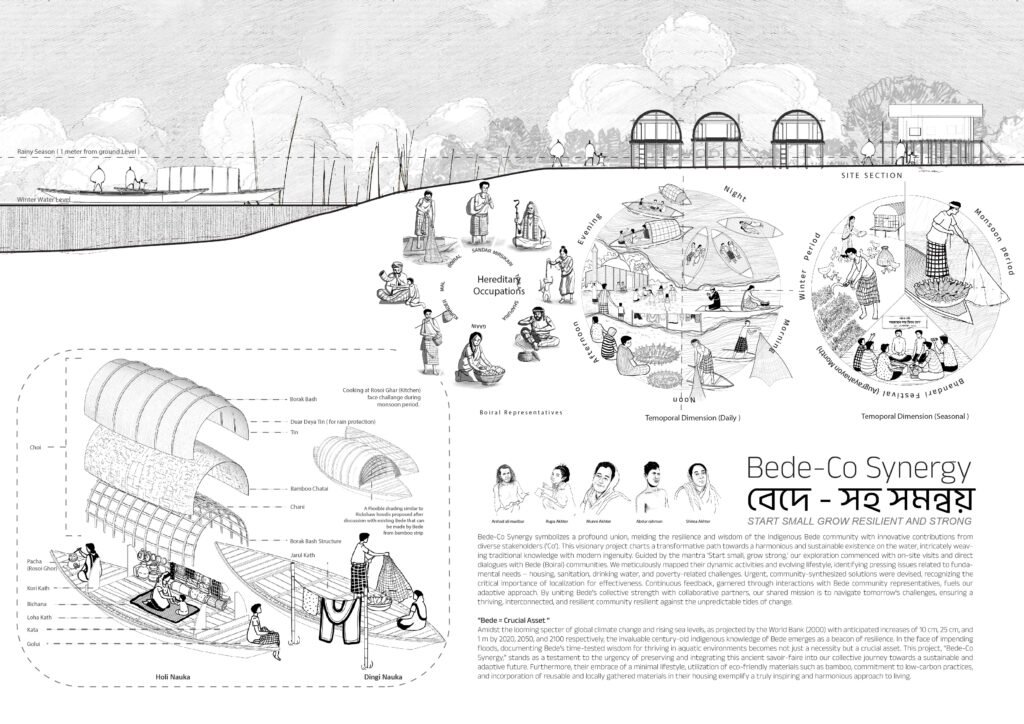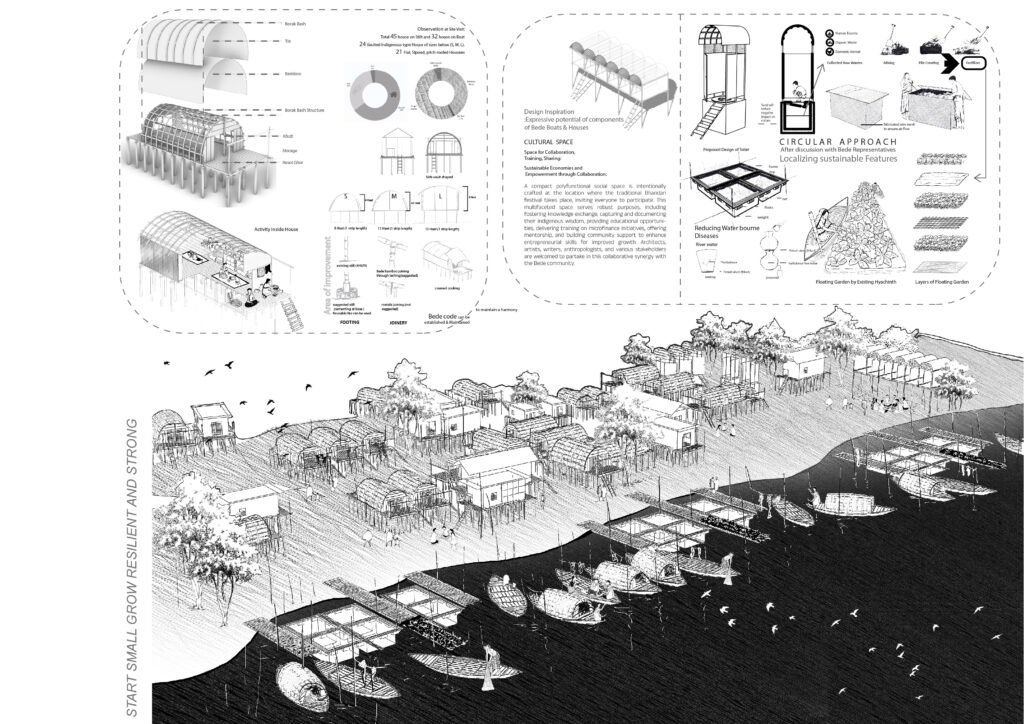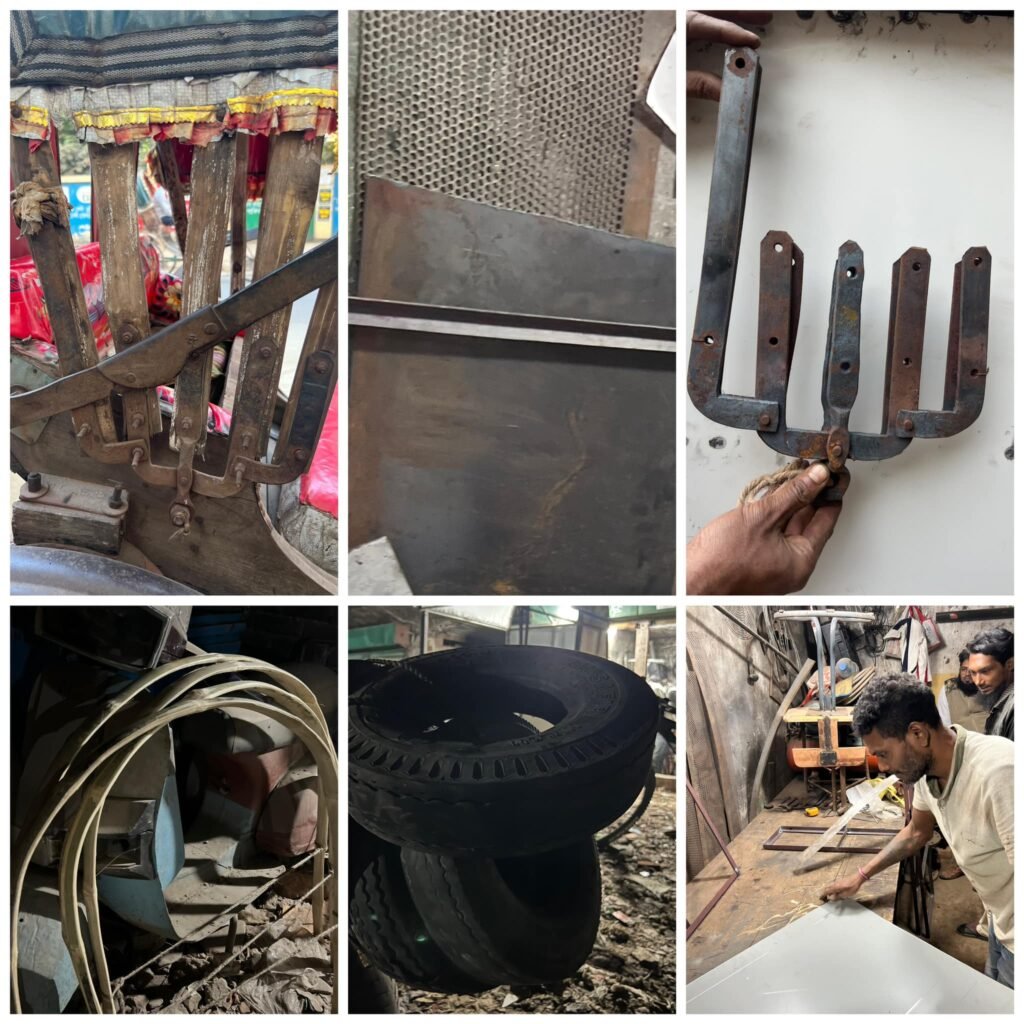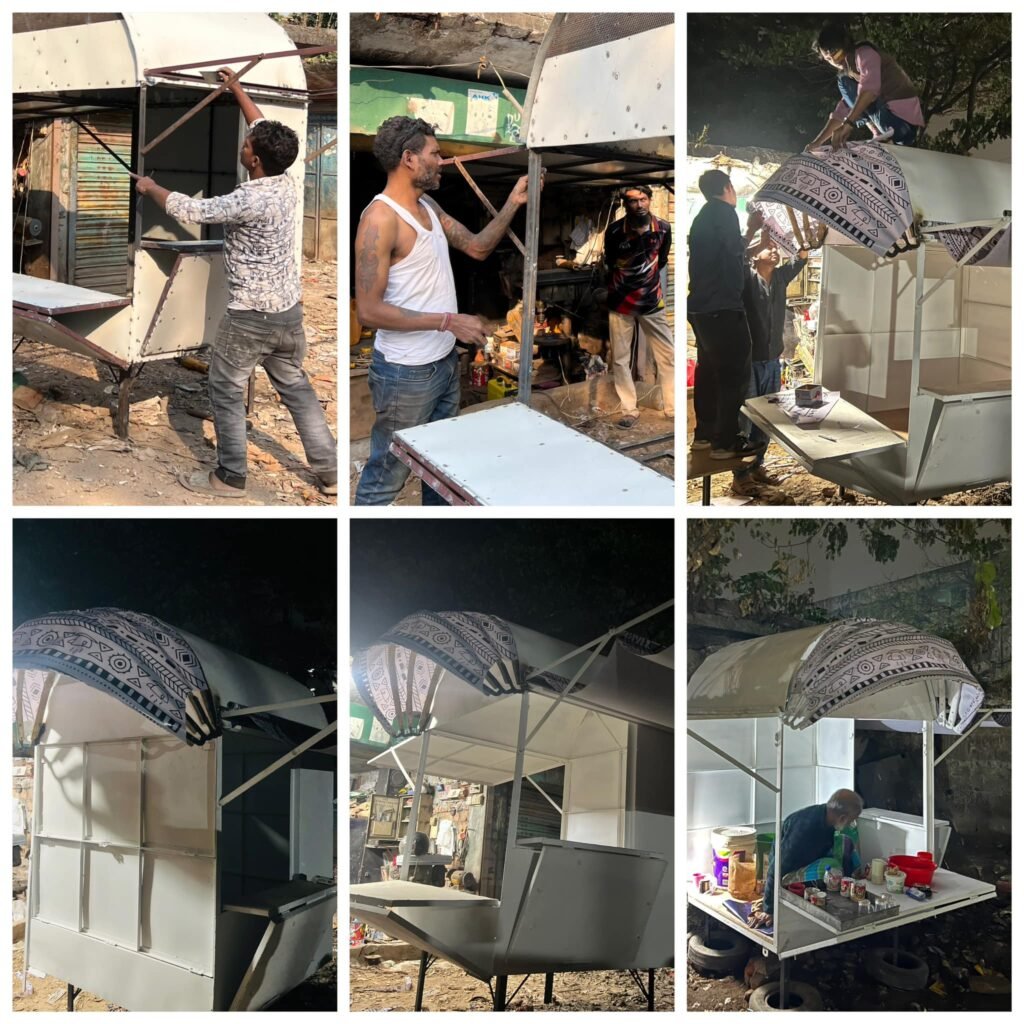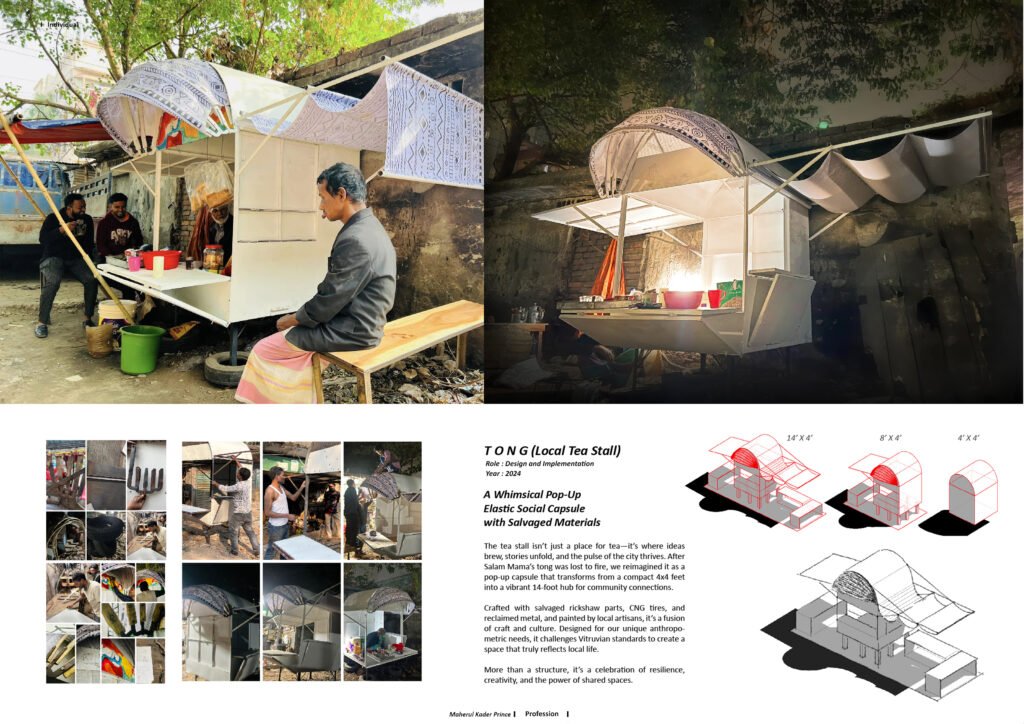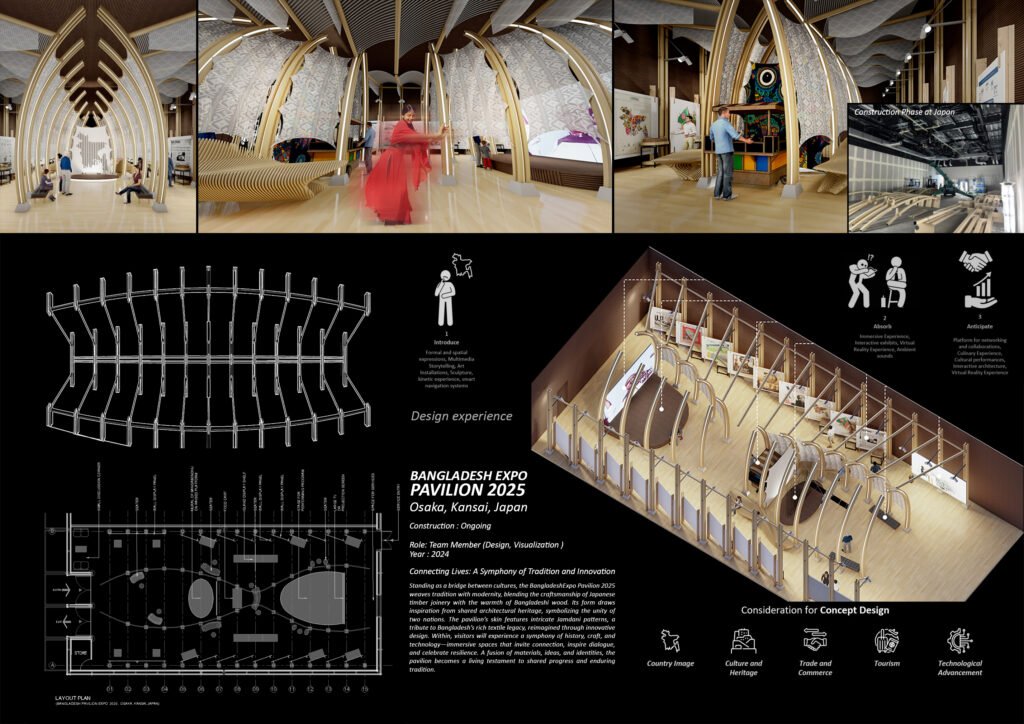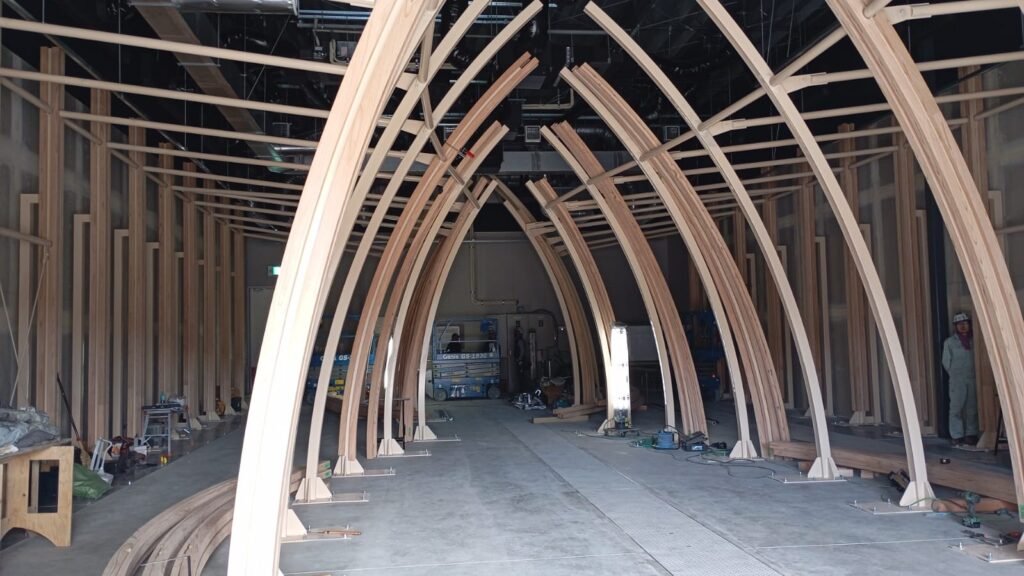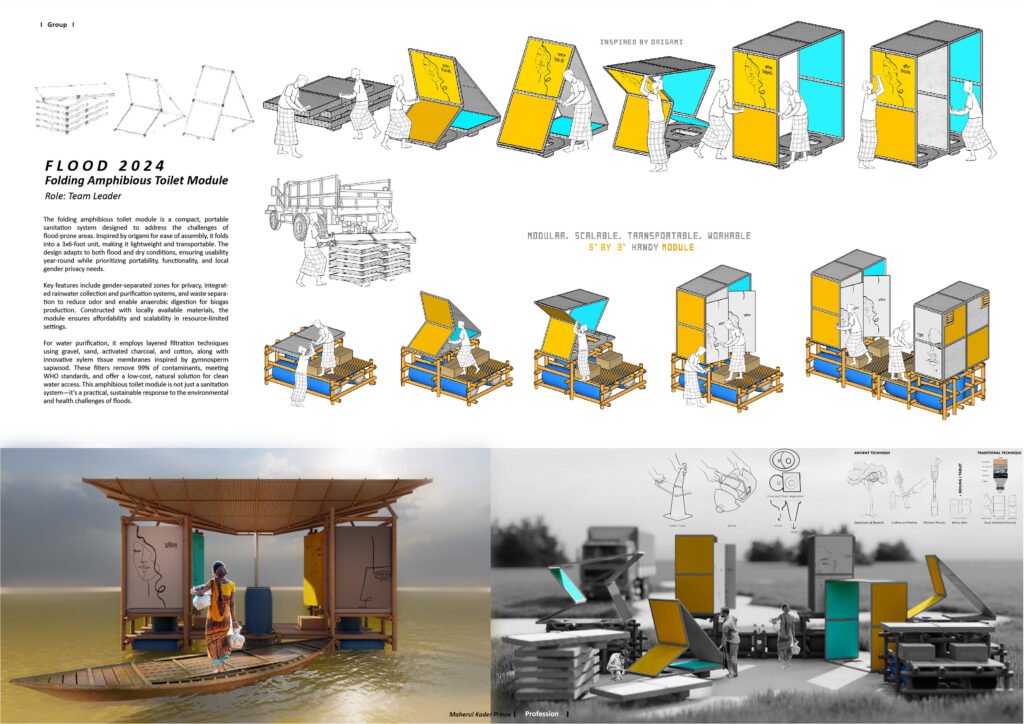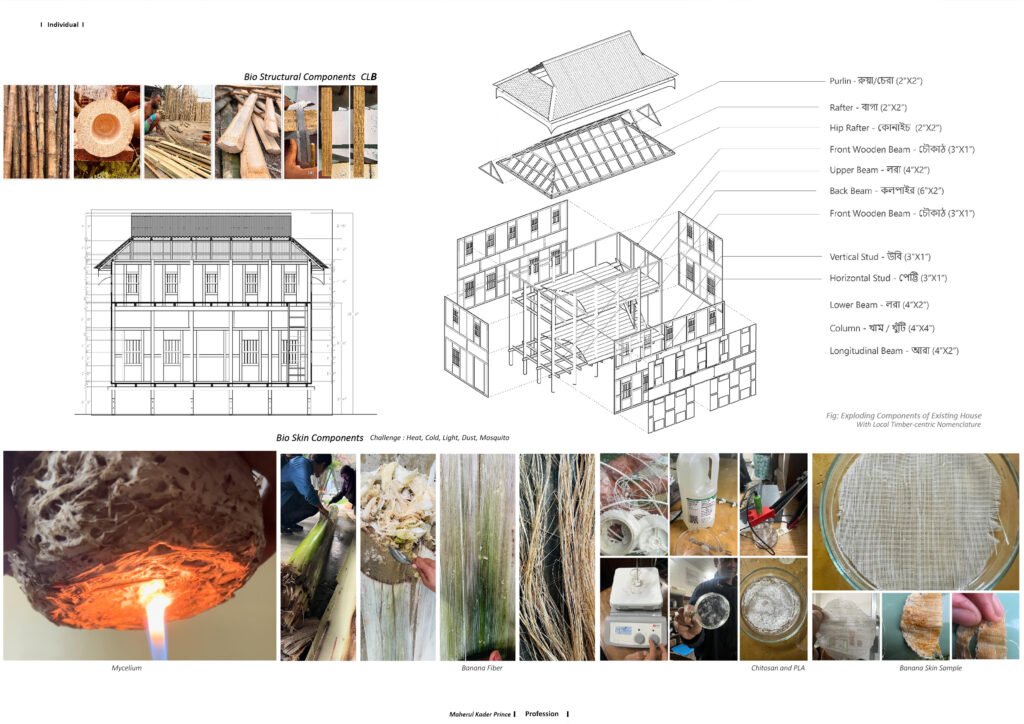P R O J E C T S
3D : Decarbonize, Democratize, Digitize
Project: Cohabit ; BUET Teacher’s Club Pavilion
Role: Team Leader and Designer
Year: 2019–2020
Whispering Layers: A Symphony of Cohabitation
In a world where the paths of nature and humans converge, architecture must tread lightly—with respect for every creature’s place in the ecosystem. This project reimagines infrastructure as a gentle touch on the earth, softly weaving together layers of life inspired by the delicate textures of nature.
The design employs lightweight tensile structures, drawing from the craftsmanship of local rickshaw wheels, to create a seamless fabric of life. Each layer of this architectural composition is infused with intent:
- Ground Layer: Welcomes the mongoose and other creatures that find solace in the shrubbery.
- Floating Deck: Forms an interactive connection between humans and the natural world.
- Canopy Layer: Nurtures life above, offering a sanctuary for squirrels, birds, and plants.
Each of these layers works in harmony, like a symphony of life. This is not merely a structure but an invitation—to belong, to share space, and to appreciate rhythms of life often overlooked. Empathy and coexistence lie at its core, ensuring that architecture becomes a gesture of cohabitation, not domination.
Project: Rejuvenation of Old Academic Building, BUET
Role: Team Leader and Designer
Year: 2021–2022
Design orchestrates an interface inspired from METAMORPHOSIS, aimed at exploring psycho-sensory, emotional appeal of loci inside a socio-cultural prototypical impression, “আঙিনা” (courtyard), which is considered as heart of the space in traditional Bengal Architecture. Through thoughtful positioning of Simulants & Envelopes with sensual colors & textures fused and gel with contemporary thoughts, events, and accentuated experience.
This project embodies the metamorphosis of materials and memories:
- Repurposed Salvage: Steel salvaged from ruins, mud teacups woven into surfaces, and a 70-year-old machine standing as a tribute to time.
- Discarded Testing Cylinders: Once forgotten, now filled with new life and purpose, symbolizing endurance and renewal.
This design is a story of past and present merging. It reclaims spaces once left idle, transforming them into a vibrant hub for learning, growth, and reflection. By celebrating endurance and revitalization, the design resonates with the resilience of materials and history itself.
Each detail serves as a testament to resourcefulness, transforming discarded remnants into vibrant, purposeful spaces. The greenery merges with reused textures, creating a sense of timeless coexistence between nature, architecture, and human intervention.
Project: Envisioning a Safe and Sustainable Life with Architecture for a Water Nomad Community in Bangladesh
Role: Team Leader and Designer
Year: Since 2023
Bede-Co Synergy
Start Small, Grow Resilient and Strong
Bede-Co Synergy symbolizes a profound union, merging the resilience and wisdom of the indigenous Bede community with innovative contributions from diverse stakeholders (Co). This visionary project charts a transformative path towards a harmonious and sustainable existence, intertwining traditional knowledge with modern ingenuity. Guided by the mantra “Start small, grow strong,” the exploration began with on-site visits and engaged dialogues with Bede-Boiral communities.
The meticulous approach involved mapping their dynamic activities and evolving lifestyle, identifying pressing issues related to fundamental needs—housing, sanitation, drinking water, and poverty-related challenges. Community-synthesized solutions were devised, recognizing the critical importance of localization for effectiveness. Continuous feedback, garnered through interactions with Bede representatives, fueled a participatory approach. By uniting Bede’s collective strength with collaborative partners, the project ensures interconnected and resilient community systems that adapt to unpredictable tides of change.
Bede: A Crucial Asset
Amidst the looming specter of global climate change and rising sea levels (10–25 cm as projected by the World Bank for 2030–2050), the invaluable cultural and indigenous knowledge of the Bede community emerges as a beacon of resilience. In the face of mending floods, their time-tested wisdom for thriving in aquatic environments is not just a necessity but a crucial asset.
This project, Bede-Co Synergy, stands as a testament to the urgency of preserving and integrating this knowledge into broader sustainability and adaptive futures. Their embrace of a minimal lifestyle, eco-friendly materials like bamboo, and commitment to low-carbon practices showcases a harmonious approach to living
Design Approach
- Localized Solutions: Merging traditional boat-building techniques with modular housing innovations tailored for floating or flood-prone environments.
- Circular Approach: Leveraging sustainable practices such as floating gardens, localized water filtration, and waste reuse to combat waterborne diseases and flooding challenges.
- Collaborative Spaces: The incorporation of cultural gathering points fosters education, livelihood training, and community resilience.
- Sustainable Materials: Utilizing renewable resources like bamboo and repurposed local materials minimizes the environmental footprint.
Project: 𝘼 𝙒𝒉𝙞𝒎𝙨𝒊𝙘𝒂𝙡 𝙋𝒐𝙥-𝙐𝒑 𝑺𝙤𝒄𝙞𝒂𝙡, 𝒆𝒍𝒂𝒔𝒕𝒊𝒄 𝘾𝒂𝙥𝒔𝙪𝒍𝙚 𝙬𝒊𝙩𝒉 𝑶𝙛𝒇-𝒕𝙝𝒆-𝑺𝙝𝒆𝑙𝒇 𝑭𝙤𝒖𝙣𝒅 𝑴𝙖𝒕𝙚𝙧𝙞𝒂𝙡𝒔
Role: Designer (Individual)
Collaboration: Archtwist, Local Artisans, Painters
Year: 2024
Following an unfortunate fire that destroyed Salam Mama’s cherished tea tong, this beloved social hub was reimagined as an elastic, whimsical sculpture. 𝐶𝑜𝑙𝑙𝑎𝑏𝑜𝑟𝑎𝑡𝑖𝑛𝑔 𝑤𝑖𝑡ℎ 𝑡ℎ𝑒 𝑠𝑘𝑖𝑙𝑙𝑒𝑑 𝑚𝑒𝑐ℎ𝑎𝑛𝑖𝑐𝑠 𝑎𝑛𝑑 𝑎𝑟𝑡𝑖𝑠𝑎𝑛𝑠 𝑓𝑟𝑜𝑚 𝑛𝑒𝑎𝑟𝑏𝑦 𝑠ℎ𝑜𝑝𝑠, 𝑤𝑒 𝑑𝑒𝑙𝑣𝑒𝑑 𝑖𝑛𝑡𝑜 𝑡ℎ𝑒𝑖𝑟 𝑐𝑟𝑎𝑓𝑡𝑖𝑛𝑔 𝑒𝑥𝑝𝑒𝑟𝑡𝑖𝑠𝑒, 𝑟𝑒𝑝𝑢𝑟𝑝𝑜𝑠𝑖𝑛𝑔 𝑠𝑎𝑙𝑣𝑎𝑔𝑒𝑑 𝑚𝑎𝑡𝑒𝑟𝑖𝑎𝑙𝑠 𝑠𝑢𝑐ℎ 𝑎𝑠 𝐶𝑁𝐺 𝑡𝑖𝑟𝑒𝑠, 𝑟𝑖𝑐𝑘𝑠ℎ𝑎𝑤 𝑐𝑜𝑚𝑝𝑜𝑛𝑒𝑛𝑡𝑠 (𝐾𝑎𝑚𝑎𝑛𝑖, 𝑃𝑎𝑛𝑗𝑎), 𝑓𝑜𝑢𝑛𝑑 ℎ𝑖𝑛𝑔𝑒𝑠, 𝑝𝑒𝑟𝑓𝑜𝑟𝑎𝑡𝑒𝑑 𝑠ℎ𝑒𝑒𝑡𝑠, 𝑎𝑛𝑑 𝑟𝑒𝑐𝑙𝑎𝑖𝑚𝑒𝑑 𝑚𝑒𝑡𝑎𝑙𝑠. 𝑇𝑜𝑔𝑒𝑡ℎ𝑒𝑟, 𝑤𝑒 𝑏𝑟𝑒𝑎𝑡ℎ𝑒𝑑 𝑙𝑖𝑓𝑒 𝑖𝑛𝑡𝑜 𝑎 𝑣𝑖𝑏𝑟𝑎𝑛𝑡, 𝑝𝑜𝑝-𝑢𝑝 𝑡𝑜𝑛𝑔, 𝑝𝑎𝑖𝑛𝑡𝑒𝑑 𝑖𝑛 𝑑𝑦𝑛𝑎𝑚𝑖𝑐 ℎ𝑢𝑒𝑠 𝑏𝑦 𝑡ℎ𝑒 𝑣𝑒𝑟𝑦 ℎ𝑎𝑛𝑑𝑠 𝑜𝑓 𝑡ℎ𝑜𝑠𝑒 𝑎𝑟𝑡𝑖𝑠𝑎𝑛𝑠, 𝑏𝑙𝑒𝑛𝑑𝑖𝑛𝑔 𝑡ℎ𝑒𝑖𝑟 𝑐𝑟𝑎𝑓𝑡 𝑖𝑛𝑡𝑜 𝑡ℎ𝑒 𝑑𝑒𝑠𝑖𝑔𝑛.
𝑇ℎ𝑒 𝑝𝑜𝑝-𝑢𝑝 𝑡𝑜𝑛𝑔 𝑖𝑠 𝑛𝑜𝑡 𝑗𝑢𝑠𝑡 𝑎 𝑠𝑡𝑟𝑢𝑐𝑡𝑢𝑟𝑒; 𝑖𝑡’𝑠 𝑎 𝑟𝑒𝑑𝑒𝑓𝑖𝑛𝑖𝑡𝑖𝑜𝑛 𝑜𝑓 𝑠𝑜𝑐𝑖𝑎𝑙 𝑠𝑝𝑎𝑐𝑒. 𝐶𝑜𝑚𝑝𝑎𝑐𝑡 𝑎𝑡 4 𝑓𝑒𝑒𝑡 𝑏𝑦 4 𝑓𝑒𝑒𝑡 𝑖𝑛 𝑖𝑡𝑠 𝑐𝑙𝑜𝑠𝑒𝑑 𝑠𝑡𝑎𝑡𝑒, 𝑖𝑡 𝑡𝑟𝑎𝑛𝑠𝑓𝑜𝑟𝑚𝑠 𝑡𝑜 𝑎𝑛 𝑖𝑚𝑝𝑟𝑒𝑠𝑠𝑖𝑣𝑒 14 𝑓𝑒𝑒𝑡 𝑖𝑛 𝑜𝑛𝑒 𝑑𝑖𝑟𝑒𝑐𝑡𝑖𝑜𝑛, 𝑓𝑙𝑒𝑥𝑖𝑛𝑔 𝑖𝑡𝑠 𝑏𝑜𝑢𝑛𝑑𝑎𝑟𝑖𝑒𝑠 𝑡𝑜 ℎ𝑜𝑠𝑡 𝑙𝑖𝑣𝑒𝑙𝑦 𝑖𝑛𝑡𝑒𝑟𝑎𝑐𝑡𝑖𝑜𝑛𝑠 𝑜𝑣𝑒𝑟 𝑐𝑢𝑝𝑠 𝑜𝑓 𝑡𝑒𝑎. 𝑇ℎ𝑜𝑢𝑔ℎ𝑡𝑓𝑢𝑙𝑙𝑦 𝑑𝑒𝑠𝑖𝑔𝑛𝑒𝑑 𝑓𝑜𝑟 𝑆𝑎𝑙𝑎𝑚 𝑀𝑎𝑚𝑎’𝑠 𝑐𝑜𝑚𝑓𝑜𝑟𝑡, 𝑖𝑡 𝑎𝑑𝑎𝑝𝑡𝑠 𝑡𝑜 𝑏𝑜𝑡ℎ 𝑠𝑖𝑡𝑡𝑖𝑛𝑔 𝑎𝑛𝑑 𝑠𝑡𝑎𝑛𝑑𝑖𝑛𝑔 𝑝𝑜𝑠𝑡𝑢𝑟𝑒𝑠, 𝑒𝘳𝑔𝘰𝑛𝘰𝑚𝘪𝑐𝘴, 𝑟𝑒𝑐𝑜𝑔𝑛𝑖𝑧𝑖𝑛𝑔 ℎ𝑜𝑤 𝑜𝑢𝑟 𝑙𝑜𝑐𝑎𝑙 𝑎𝑛𝑡ℎ𝑟𝑜𝑝𝑜𝑚𝑒𝑡𝑟𝑖𝑐 𝑛𝑒𝑒𝑑𝑠 𝑑𝑖𝑣𝑒𝑟𝑔𝑒 𝑓𝑟𝑜𝑚 𝑡ℎ𝑒 𝑉𝑖𝑡𝑟𝑢𝑣𝑖𝑎𝑛 𝑠𝑡𝑎𝑛𝑑𝑎𝑟𝑑𝑠 𝑜𝑓𝑡𝑒𝑛 𝑑𝑖𝑐𝑡𝑎𝑡𝑖𝑛𝑔 𝑎𝑟𝑐ℎ𝑖𝑡𝑒𝑐𝑡𝑢𝑟𝑎𝑙 𝑑𝑒𝑠𝑖𝑔𝑛.
𝑇ℎ𝑖𝑠 𝑡𝑜𝑛𝑔 𝑡𝑟𝑎𝑛𝑠𝑐𝑒𝑛𝑑𝑠 𝑓𝑢𝑛𝑐𝑡𝑖𝑜𝑛𝑎𝑙𝑖𝑡𝑦. 𝐼𝑡’𝑠 𝑎𝑛 𝑖𝑛𝑣𝑖𝑡𝑎𝑡𝑖𝑜𝑛—𝑎 𝑐𝑎𝑛𝑣𝑎𝑠 𝑓𝑜𝑟 𝑟𝑖𝑐𝑘𝑠ℎ𝑎𝑤 𝑝𝑎𝑖𝑛𝑡𝑒𝑟𝑠, 𝑙𝑜𝑐𝑎𝑙 𝑎𝑟𝑡𝑖𝑠𝑡𝑠, 𝑎𝑛𝑑 𝑡ℎ𝑒 𝑐𝑜𝑚𝑚𝑢𝑛𝑖𝑡𝑦 𝑡𝑜 𝑙𝑒𝑎𝑣𝑒 𝑡ℎ𝑒𝑖𝑟 𝑚𝑎𝑟𝑘, 𝑓𝑖𝑙𝑙𝑖𝑛𝑔 𝑖𝑡𝑠 𝑤ℎ𝑖𝑡𝑒 𝑠𝑝𝑎𝑐𝑒𝑠 𝑤𝑖𝑡ℎ 𝑠𝑡𝑜𝑟𝑖𝑒𝑠, 𝑐𝑜𝑙𝑜𝑟𝑠, 𝑎𝑛𝑑 𝑐𝑢𝑙𝑡𝑢𝑟𝑒. 𝐵𝑦 𝑏𝑙𝑒𝑛𝑑𝑖𝑛𝑔 𝑓𝑜𝑢𝑛𝑑 𝑚𝑎𝑡𝑒𝑟𝑖𝑎𝑙𝑠, 𝑙𝑜𝑐𝑎𝑙 𝑎𝑟𝑡𝑖𝑠𝑡𝑟𝑦, 𝑎𝑛𝑑 𝑒𝑙𝑎𝑠𝑡𝑖𝑐 𝑑𝑒𝑠𝑖𝑔𝑛, 𝑡ℎ𝑖𝑠 𝑤ℎ𝑖𝑚𝑠𝑖𝑐𝑎𝑙 𝑡𝑜𝑛𝑔 𝑛𝑜𝑡 𝑜𝑛𝑙𝑦 𝑟𝑒𝑣𝑖𝑣𝑒𝑠 𝑆𝑎𝑙𝑎𝑚 𝑀𝑎𝑚𝑎’𝑠 𝑡𝑒𝑎 𝑐𝑜𝑟𝑛𝑒𝑟 𝑏𝑢𝑡 𝑟𝑒𝑖𝑚𝑎𝑔𝑖𝑛𝑒𝑠 𝑖𝑡 𝑎𝑠 𝑎 𝑣𝑖𝑏𝑟𝑎𝑛𝑡, 𝑐𝑜𝑙𝑙𝑒𝑐𝑡𝑖𝑣𝑒 𝑐𝑒𝑙𝑒𝑏𝑟𝑎𝑡𝑖𝑜𝑛 𝑜𝑓 𝑟𝑒𝑠𝑖𝑙𝑖𝑒𝑛𝑐𝑒 𝑎𝑛𝑑 𝑐𝑟𝑒𝑎𝑡𝑖𝑣𝑖𝑡𝑦.
𝑇𝑜 𝑚𝑒 , 𝑇𝑒𝑎 𝑠𝑡𝑎𝑙𝑙𝑠 𝑎𝑟𝑒 𝑎 𝑝𝑙𝑎𝑐𝑒 𝑓𝑟𝑜𝑚 𝑤ℎ𝑒𝑟𝑒 𝑖𝑑𝑒𝑎𝑠, ℎ𝑢𝑚𝑎𝑛 𝑛𝑎𝑡𝑢𝑟𝑒 𝑜𝑓 𝑎 𝑐𝑖𝑡𝑦 𝑝𝑎𝑡𝑡𝑒𝑟𝑛𝑠 𝑐𝑎𝑛 𝑏𝑒 𝑢𝑛𝑑𝑒𝑟𝑠𝑡𝑜𝑜𝑑 , 𝑤ℎ𝑒𝑟𝑒 𝑖𝑑𝑒𝑎𝑠 𝑠𝑝𝑟𝑖𝑛𝑔 𝑜𝑢𝑡 , 𝑒𝑣𝑜𝑙𝑒 . 𝑆𝑢𝑐ℎ 𝑣𝑖𝑏𝑟𝑎𝑛𝑡 𝑠𝑜𝑐𝑖𝑎𝑙 𝑠𝑝𝑎𝑐𝑒𝑠 𝑤𝑖𝑡ℎ 𝑓𝑢𝑙𝑙 𝑜𝑓 𝑒𝑛𝑒𝑟𝑔𝑦 𝑏𝑒𝑖𝑛𝑔 𝑠ℎ𝑎𝑑𝑜𝑤𝑒𝑑 𝑏𝑦 𝑐𝑜𝑛𝑡𝑒𝑚𝑝𝑜𝑟𝑎𝑟𝑦 𝑑𝑒𝑣𝑒𝑙𝑜𝑝𝑚𝑒𝑛𝑡𝑠 𝑒𝑣𝑒𝑛 𝑏𝑎𝑛𝑛𝑒𝑑 𝑏𝑦 𝑐𝑖𝑡𝑦 𝑐𝑜𝑟𝑝𝑜𝑟𝑎𝑡𝑖𝑜𝑛𝑠 𝑖𝑛 𝑠𝑜𝑚𝑒 𝑝𝑙𝑎𝑐𝑒𝑠. 𝑇𝑒𝑎 𝑠𝑡𝑎𝑙𝑙 𝑖𝑠 𝑎 𝑠𝑜𝑐𝑖𝑎𝑙 𝑝𝑙𝑎𝑐𝑒 𝑡ℎ𝑎𝑡 𝑒𝑟𝑎𝑠𝑒 𝑡ℎ𝑒 𝑏𝑜𝑢𝑛𝑑𝑎𝑟𝑖𝑒𝑠 𝑏𝑒𝑡𝑤𝑒𝑒𝑛 𝑐𝑖𝑡𝑦’𝑠 𝑐𝑖𝑟𝑐𝑢𝑙𝑎𝑡𝑖𝑜𝑛 𝑛𝑒𝑡𝑤𝑜𝑟𝑘𝑠 𝑎𝑛𝑑 𝑏𝑢𝑖𝑙𝑡 𝑒𝑛𝑣𝑖𝑟𝑜𝑛𝑚𝑒𝑛𝑡.
𝐼𝑡’𝑠 𝑎 𝑠𝑒𝑒𝑑 𝑜𝑓 𝑝𝑜𝑠𝑠𝑖𝑏𝑖𝑙𝑖𝑡𝑦—𝑗𝑢𝑠𝑡 𝑠𝑡𝑎𝑟𝑡, 𝑎𝑛𝑑 𝑙𝑒𝑡’𝑠 𝑠𝑒𝑒 𝑤ℎ𝑒𝑟𝑒 𝑖𝑡 𝑔𝑟𝑜𝑤𝑠.
Bengal Bio-Lego
A Circular, Low-Carbon Future Rooted in Heritage
Individual Project/Design
Year: Since 2023
Bengal Bio-Lego redefines rural construction by integrating Cross-Laminated Bamboo (CLB), matured Coconut and Betel Nut Trees, and bio-based skin materials into a modular, parametric system. Drawing from Bangladesh’s rich timber-centric nomenclature for “Purlin,” “Rafters,” “Beam,” “Column,” “Stud”—this approach preserves vernacular traditions while advancing sustainable innovation.
In rural Bangladesh, traditional timber houses, refined through centuries of experimentation, have long been central to local architecture. These timber-framed dwellings are characterized by structural components such as posts (‘Khuti’), horizontal beams (‘Choukath’), end beams (‘Kachpair’ and ‘Kolpair’/’Kodla’), sills (‘Peti’), lintels (‘Choukath’), internal beams (‘Ara’), purlins (‘Chera’), jack rafters (‘Rua’/’Madaam’), and hip rafters (‘Konaich’), forming the essential framework of these vernacular structures. Bengal Bio-Lego builds on this legacy, modernizing it through sustainable materials and parametric precision.
At its core, structural Lego blocks utilize 3-4-year-old bamboo, matured coconut, and betel nut trees—naturally harvested at the end of their lifecycle. Skin Lego panels incorporate bamboo fiber, banana fiber, and coconut fiber blended with PLA and chitosan, ensuring biodegradability. Additionally, mycelium-based components infused with agricultural waste harness Bangladesh’s agrarian abundance, fostering circular, low-carbon construction.
Designed through Karamba 3D-driven parametric analysis, Bengal Bio-Lego ensures precision, adaptability, and resilience, merging biomaterials with local craftsmanship. By embracing heritage-driven innovation, it offers biodegradable, renewable alternatives that preserve structural integrity, cultural continuity, and environmental harmony—paving the way for a sustainable rural future.

Bio Structure Lego (Cross Laminated Bamboo, Matured Areca Nut and Coconut Tree )

